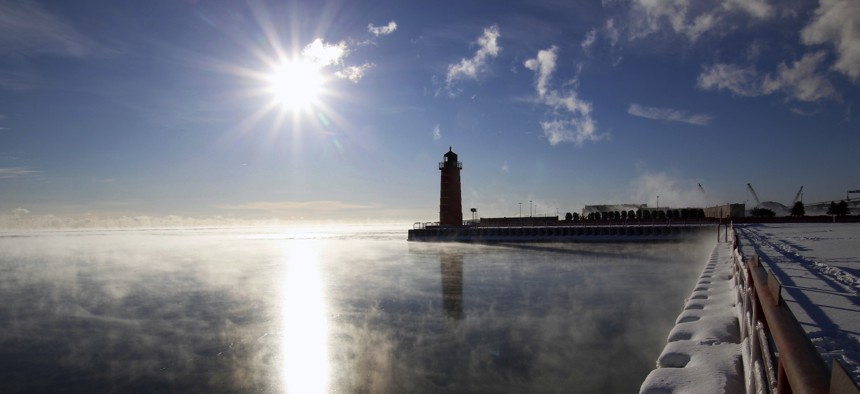Dangerous Winter Blast Puts Upper Midwest, Great Lakes in Deep Freeze

Steam rises from Lake Michigan in Milwaukee Carrie Antlfinger / AP Photo
Polar vortex brings coldest temperatures to many areas in decades.
Dangerously cold weather coupled with major snowfall in parts of the Upper Midwest and Great Lakes states kept government agencies and schools closed on Monday as the polar vortex plunges south bringing with it some of the coldest temperatures many areas have seen in decades. Subzero temperatures will stick around the region over the next few days. The Milwaukee Journal-Sentinel put it this way: “Sure, it gets cold in Wisconsin, but not this cold.”
Wisconsin Gov. Tony Evers declared a state of emergency on Monday, citing the “heavy snowfall, bitter and potentially life-threatening temperatures and blowing and drifting snow” across the state.
State and local plowing crews across the region had their hands full with the winter storm. In Washington County, northwest of Milwaukee, public works crews on Monday with 20 trucks cleared more than a foot of snow from upwards of 1,000 lanes miles.
Travel was hazardous across the region. The Michigan Department of Transportation urged in a tweet on Monday: “If you absolutely have to be on the roads today, give yourself plenty of time, as well as plenty of space between yourself and your fellow drivers.”
After being closed on Monday, state offices on Michigan’s Lower Peninsula will reopen Tuesday.
Minnesota Gov. Tim Walz said he would defer to local school districts whether to close "because they know best the conditions in their area and how to keep their students safe." Due to the hazardous road conditions and dangerous cold, schools in Minneapolis and St. Paul in Minnesota and Grand Rapids, Michigan are expected to be closed for the next few days.
In Chicago, city officials, including Mayor Rahm Emanuel, urged residents to stay home and limit time outside during the deep freeze. City warming centers at libraries, police stations and community centers will be open for the next few days.
“Our city-funded shelters will stay open 24 hours so that residents do not need to leave the facility during the day,” Lisa Morrison Butler, commissioner of Chicago’s Department of Family and Support Services, said, according to WTTW. Tuesday’s low temperature in Chicago is forecasted to be minus-25 degrees, with even colder wind chills.
In Sioux Falls, South Dakota, where forecasters are expecting wind chills of minus-50 on Wednesday, local homeless shelters are expecting to see an influx of people. "We will find a spot for people to come in," Bishop Dudley House development coordinator Amanda Stidd told the Argus Leader, “whether that's lining cots and mats up where they can, putting people in day rooms or using hospital beds in the shelter's medical respite rooms.”
Michael Grass is Executive Editor of Route Fifty and is based in Seattle.
NEXT STORY: Streamlining Local Health Department Inspections and Permitting






